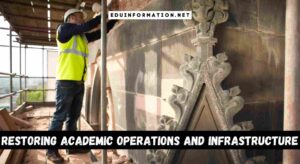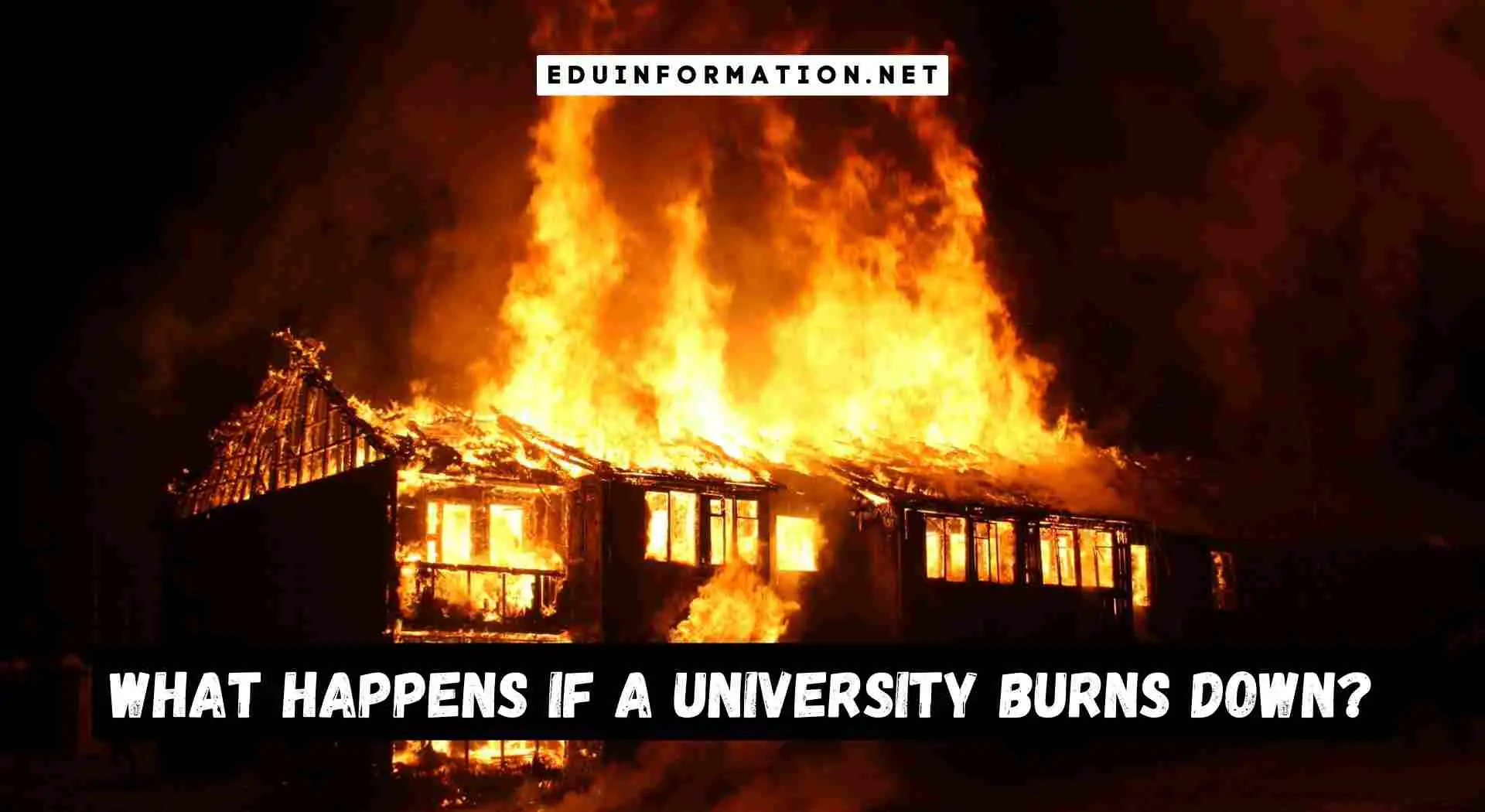If a university burns down, it can lead to devastating consequences for the students and faculty. The loss of infrastructure, resources, and records can hinder academic progress and disrupt the learning environment.
It may require relocation of classes, reconstruction of facilities, and a significant financial burden on the institution. The students may face challenges in completing their degrees on time, and the faculty may lose their research and teaching materials. Moreover, the university’s reputation may be damaged, impacting future enrollment and funding opportunities.
The community also suffers as the university serves as a hub for education and contributes to the local economy. Recovery from such a disaster requires extensive planning, support, and resources to rebuild and restore normalcy.
Immediate Impacts On Students And Staff

Disruption Of Classes And Education:
- Students may face significant disruptions to their studies and educational progress due to the immediate impacts of a university burning down.
- The loss of classrooms, laboratories, and other facilities can halt regular classes, resulting in delays and interruptions to coursework.
- Students may experience difficulty accessing textbooks, research materials, and other resources needed for their studies.
- Practical and hands-on learning experiences, such as internships or field trips, may be canceled or postponed indefinitely.
- The sudden loss of academic support services, such as tutoring or counseling, can have a further negative impact on a student’s ability to succeed academically.
Safety Concerns For Students And Staff:
- The immediate aftermath of a university fire can present significant safety concerns for both students and staff.
- Evacuation protocols must be followed, ensuring the safe removal of individuals from the affected areas and the entire campus.
- Injuries or health issues related to the fire, such as smoke inhalation or burns, may require immediate medical attention.
- Displaced students and staff may face challenges finding temporary accommodations and ensuring their safety outside the university premises.
- Emergency response teams must assess the structural integrity of the affected buildings to prevent any further harm or accidents.
Emotional And Psychological Effects:
- The emotional and psychological impact of a university fire on students and staff can be overwhelming and long-lasting.
- Students may experience a sense of loss, grief, and anxiety as their academic environment and personal belongings may be destroyed.
- Staff members may also face emotional distress, worrying about the impact on their students and possibly their job security.
- The disruption of daily routines and a sense of instability can lead to increased stress levels among both students and staff.
- Psychological support services, such as counseling or therapy, are essential to help individuals cope with the trauma and restore a sense of normalcy.
Remember, this markdown-formatted content is not intended to serve as an introduction or have a concluding paragraph. Instead, it focuses on delivering informative and concise information about the immediate impacts on students and staff if a university burns down.
Financial Consequences For The University

A disaster like a fire can have severe financial implications for a university. Let’s explore the specific ways in which a university may suffer financially after a devastating fire:
Loss Of Buildings And Infrastructure:
- Destruction of campus buildings: The university may lose crucial academic and administrative buildings, including classrooms, libraries, laboratories, and offices. These losses can hinder day-to-day operations and disrupt teaching, research, and other activities.
- Cost of rebuilding: Reconstructing damaged or destroyed buildings can be an expensive endeavor. The university will need to allocate substantial funds to rebuild the infrastructure and make necessary repairs.
- Impact on on-campus housing: If dormitories are affected by the fire, the university may need to find temporary accommodation for students. This can incur additional costs and disrupt normal housing arrangements.
Equipment And Research Materials Destruction:
- Loss of scientific equipment: Laboratories are often equipped with expensive and highly specialized instruments and machinery. A fire may destroy critical research tools, leading to substantial financial losses.
- Damage to research materials: Years of research work, data, and samples stored in laboratories may be lost or severely damaged in a fire. This loss can set back ongoing research projects and require significant investments to replace or replicate the lost materials.
Revenue Loss From Tuition And Research Grants:
- Disrupted tuition payments: If the university is unable to continue its regular academic activities due to the fire, students may face delays in their education and be unable to pay their tuition fees. This can lead to a loss of revenue for the university.
- Impact on research grants: Ongoing research projects may suffer disruptions or even complete loss due to fire-related damages. This can result in a loss of research grants and funding from external sources, affecting the university’s financial stability.
A university fire can cause grave financial consequences. From the loss and rebuilding of buildings to the destruction of equipment, research materials, and revenue loss from tuition and research grants, the financial impact can be significant and long-lasting. Ensuring adequate insurance coverage and disaster preparedness can help universities mitigate these potential financial setbacks.
Effect On The Local Community And Economy
Decrease In Employment Opportunities:
- The burning down of a university can have a significant impact on the local community, particularly in terms of employment opportunities.
- A decrease in employment opportunities may occur due to the following reasons:
- Displacement of university staff: The fire could lead to a displacement of faculty and staff members, resulting in job losses.
- Suspension of construction projects: If the university was undergoing expansion or renovation projects, the fire may interrupt these plans, leading to temporary or permanent job cuts.
- Halting research and development: The destruction of research facilities can impact ongoing projects, leading to a decrease in employment opportunities for researchers and their support staff.
- Reduced demand for services: The absence of a university can lead to a decrease in demand for services such as food vendors, transportation providers, and printing shops that catered primarily to the student population.
- The decrease in employment opportunities can have long-lasting effects on the local community, resulting in financial hardships for individuals and businesses alike.
Impact On Local Businesses And Services:
- The burning down of a university can have a severe impact on local businesses and services that relied on the student and faculty population for customers.
- The impact on local businesses and services can be observed in the following ways:
- Decrease in customer base: Without a university, local businesses may experience a significant decline in their customer base, resulting in reduced sales and potential closures.
- Loss of revenue: Businesses that specifically catered to the university community, such as bookstores, cafes, and rental services, may suffer substantial revenue losses due to the absence of their primary customers.
- Closure of ancillary services: Service providers that relied heavily on the university, such as transportation companies, hotels, and event venues, may face closure or downsizing due to the decline in demand.
- The impact on local businesses and services can lead to economic instability, unemployment, and a decrease in the overall quality of life for the local community.
Loss Of Cultural And Educational Hub:
- A university acts as a hub of cultural and educational activities within a community, and its loss can be deeply felt by the local population.
- The loss of a cultural and educational hub can have the following implications:
- Demise of community events: Universities often host various cultural events, such as concerts, lectures, and exhibitions, which contribute to the local community’s social and cultural fabric. The absence of a university means the loss of these events, impacting the community’s access to cultural activities.
- Disruption of educational services: The burning down of a university disrupts educational services, impacting the educational journey of current and prospective students. This loss can also hinder the intellectual growth and development of the local community.
- Decline in intellectual exchange: Universities serve as centers for intellectual exchange, fostering discussions, debates, and research. The loss of a university means a decline in these intellectual interactions within the community, limiting the opportunities for knowledge sharing and innovation.
- The loss of a cultural and educational hub due to a university fire is not only an emotional setback but also has long-term consequences for the overall development and vibrancy of the local community.
Restoring Academic Operations And Infrastructure

When a university experiences a devastating fire that damages its buildings and facilities, the process of restoring academic operations and infrastructure is crucial. It involves various aspects such as rebuilding damaged buildings, replacing critical equipment and materials, and redesigning the curriculum for continuity.
Let’s delve into each of these components to understand how universities can recover from such a catastrophic event.
Rebuilding Damaged Buildings And Facilities:
Recovering from a fire requires the university to rebuild damaged buildings and facilities. Here are the steps involved in this process:
- Assessment and planning: The first step is to assess the extent of the damage and devise a comprehensive plan for the rebuilding process.
- Renovation or reconstruction: Depending on the severity of the damage, the university may opt for renovation or reconstruction of the affected structures.
- Compliance with safety standards: During the rebuilding phase, special attention must be given to adhering to safety standards and implementing fire-resistant measures.
Replacing Critical Equipment And Materials:
A fire can also lead to the destruction of critical equipment and materials necessary for academic operations. Below are the actions taken in restoring these essential resources:
- Inventory assessment: Conducting a thorough inventory assessment helps identify the equipment and materials that need replacement.
- Procurement and installation: The university must promptly procure the necessary equipment and materials required for different academic departments. These items are then installed to ensure smooth functioning.
- Testing and calibration: After installation, rigorous testing and calibration procedures are carried out to guarantee the proper functioning of the replaced equipment.
Redesigning The Curriculum For Continuity:
With the physical aspects addressed, the university must consider redesigning the curriculum to ensure educational continuity.
- Identifying the impact: Analyzing the impact of the fire on the curriculum is crucial. This includes assessing the loss of materials, coursework, and resources that need replacement or restructuring.
- Developing alternative plans: Creating alternative plans for affected courses helps maintain the academic progress of students. These plans may involve temporary classrooms, online resources, or relocation to nearby facilities.
- Collaboration and communication: Effective communication with faculty, staff, and students is essential during the curriculum redesign process. Collaboration between different departments facilitates the development of innovative continuity solutions.
Restoring academic operations and infrastructure after a fire is a challenging process that requires meticulous planning, resource allocation, and collaboration. By prioritizing the rebuilding of damaged buildings, replacing critical equipment and materials, and redesigning the curriculum for continuity, universities can successfully overcome the adverse effects of such incidents and provide their students with a conducive learning environment once again.
Financial Recovery And Fundraising Efforts
In the unfortunate event that a university burns down, the financial implications can be overwhelming. However, there are various avenues for financial recovery and fundraising efforts that can help the institution rebuild and continue its operations. Let’s explore the key strategies below:
Insurance Claims And Funding Allocation
- Insurance claims: The university’s insurance policy will play a crucial role in recovering from the financial setback caused by the fire. Here’s how insurance claims can help with the recovery process:
- Filing an insurance claim promptly to assess the extent of damage and determine the coverage.
- Engaging with insurance adjusters to ensure a fair evaluation of losses incurred.
- Negotiating with insurance companies to obtain the maximum possible compensation.
- Funding allocation: Once the insurance claim is settled, a detailed assessment of the university’s financial needs should be carried out to allocate funds appropriately. Consider the following steps:
- Prioritizing immediate needs such as temporary facilities, equipment replacement, and basic infrastructure.
- Allocating funds for repairing or rebuilding damaged academic buildings, dormitories, and administrative offices.
- Scheduling a clear timeline for financial disbursements to support the rebuilding and recovery phases effectively.
Launching Fundraising Campaigns
To bridge the gap between insurance coverage and the overall cost of recovery, launching targeted fundraising campaigns can significantly contribute to the financial rehabilitation of the university. Here are a few effective ways to initiate such campaigns:
- Online platforms: Create an engaging online campaign that appeals to the public’s sentiment and connects them emotionally with the university’s cause. Utilize social media, university websites, and crowdfunding platforms to reach a wider audience.
- Alumni and community involvement: Engage alumni and the local community by hosting fundraising events, auctions, or charity drives, encouraging active participation and support.
- Corporate sponsorships: Collaborate with local and national businesses to secure corporate sponsorships, financial donations, or in-kind contributions to support the rebuilding process.
- Donation matching: Encourage philanthropists, foundations, and corporations to match the donations received, amplifying the impact of every contribution.
Seeking Support From Alumni And Philanthropic Organizations
In addition to launching fundraising campaigns, universities can reach out to their alumni network and philanthropic organizations for further financial support. Consider the following approaches:
- Alumni donations: Develop a comprehensive alumni fundraising program to encourage alumni to contribute towards the university’s recovery. Engage alumni through personalized appeals, highlighting the significance of their support.
- Endowment funds: Explore the possibility of utilizing endowment funds to aid in the recovery efforts. This can be achieved by assessing the university’s endowment policies and working closely with the trustees to allocate funds as per the recovery plan.
- Engagement with philanthropic organizations: Develop strategic partnerships with philanthropic organizations and foundations that align with the university’s mission and vision. Seek financial assistance through grants, scholarships, and collaborative projects.
By taking proactive measures and implementing effective financial recovery and fundraising strategies, universities can overcome the challenges posed by a fire-related disaster and rebuild themselves stronger than ever before.
Conclusion
Considering the significant impact that a university burning down can have on students, faculty, and the surrounding community, it is crucial to have contingency plans in place. The immediate response should focus on ensuring the safety and well-being of everyone affected.
Evacuation procedures, temporary accommodations, and the preservation of important records and data should be prioritized. After the initial chaos subsides, efforts to rebuild and restore the university should commence. This will involve working closely with insurance agencies, architects, and construction teams to bring the campus back to its former glory.
It is also vital to communicate updates and support to students, faculty, and alumni throughout the recovery process. Additionally, steps should be taken to prevent future incidents, such as the implementation of fire safety measures and regular inspections. Although a university fire is a devastating event, with careful planning and swift action, it is possible to overcome the challenges and rebuild a thriving educational community.

